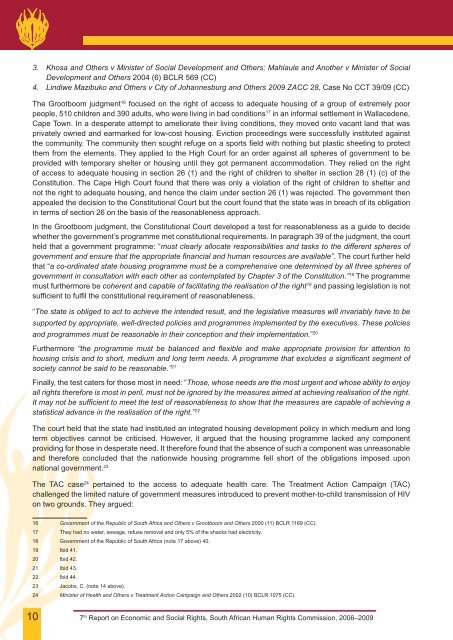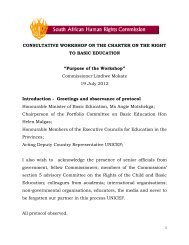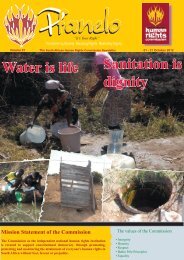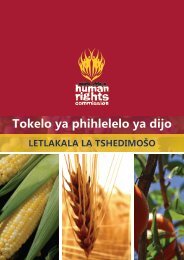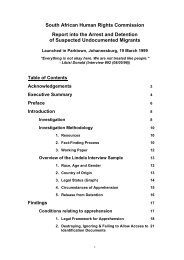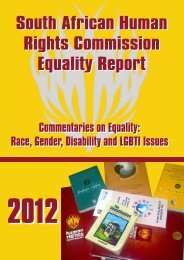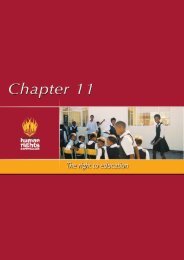Chapter 1 - South African Human Rights Commission
Chapter 1 - South African Human Rights Commission
Chapter 1 - South African Human Rights Commission
- No tags were found...
Create successful ePaper yourself
Turn your PDF publications into a flip-book with our unique Google optimized e-Paper software.
3. Khosa and Others v Minister of Social Development and Others; Mahlaule and Another v Minister of Social<br />
Development and Others 2004 (6) BCLR 569 (CC)<br />
4. Lindiwe Mazibuko and Others v City of Johannesburg and Others 2009 ZACC 28, Case No CCT 39/09 (CC)<br />
The Grootboom judgment 16 focused on the right of access to adequate housing of a group of extremely poor<br />
people, 510 children and 390 adults, who were living in bad conditions 17 in an informal settlement in Wallacedene,<br />
Cape Town. In a desperate attempt to ameliorate their living conditions, they moved onto vacant land that was<br />
privately owned and earmarked for low-cost housing. Eviction proceedings were successfully instituted against<br />
the community. The community then sought refuge on a sports eld with nothing but plastic sheeting to protect<br />
them from the elements. They applied to the High Court for an order against all spheres of government to be<br />
provided with temporary shelter or housing until they got permanent accommodation. They relied on the right<br />
of access to adequate housing in section 26 (1) and the right of children to shelter in section 28 (1) (c) of the<br />
Constitution. The Cape High Court found that there was only a violation of the right of children to shelter and<br />
not the right to adequate housing, and hence the claim under section 26 (1) was rejected. The government then<br />
appealed the decision to the Constitutional Court but the court found that the state was in breach of its obligation<br />
in terms of section 26 on the basis of the reasonableness approach.<br />
In the Grootboom judgment, the Constitutional Court developed a test for reasonableness as a guide to decide<br />
whether the government’s programme met constitutional requirements. In paragraph 39 of the judgment, the court<br />
held that a government programme: “must clearly allocate responsibilities and tasks to the different spheres of<br />
government and ensure that the appropriate nancial and human resources are available”. The court further held<br />
that “a co-ordinated state housing programme must be a comprehensive one determined by all three spheres of<br />
government in consultation with each other as contemplated by <strong>Chapter</strong> 3 of the Constitution.” 18 The programme<br />
must furthermore be coherent and capable of facilitating the realisation of the right 19 and passing legislation is not<br />
suf cient to full the constitutional requirement of reasonableness.<br />
“The state is obliged to act to achieve the intended result, and the legislative measures will invariably have to be<br />
supported by appropriate, well-directed policies and programmes implemented by the executives. These policies<br />
and programmes must be reasonable in their conception and their implementation.” 20<br />
Furthermore “the programme must be balanced and exible and make appropriate provision for attention to<br />
housing crisis and to short, medium and long term needs. A programme that excludes a signi cant segment of<br />
society cannot be said to be reasonable.” 21<br />
Finally, the test caters for those most in need: “Those, whose needs are the most urgent and whose ability to enjoy<br />
all rights therefore is most in peril, must not be ignored by the measures aimed at achieving realisation of the right.<br />
It may not be suf cient to meet the test of reasonableness to show that the measures are capable of achieving a<br />
statistical advance in the realisation of the right.” 22<br />
The court held that the state had instituted an integrated housing development policy in which medium and long<br />
term objectives cannot be criticised. However, it argued that the housing programme lacked any component<br />
providing for those in desperate need. It therefore found that the absence of such a component was unreasonable<br />
and therefore concluded that the nationwide housing programme fell short of the obligations imposed upon<br />
national government. 23<br />
The TAC case 24 pertained to the access to adequate health care. The Treatment Action Campaign (TAC)<br />
challenged the limited nature of government measures introduced to prevent mother-to-child transmission of HIV<br />
on two grounds. They argued:<br />
16 Government of the Republic of <strong>South</strong> Africa and Others v Grootboom and Others 2000 (11) BCLR 1169 (CC).<br />
17 They had no water, sewage, refuse removal and only 5% of the shacks had electricity.<br />
18 Government of the Republic of <strong>South</strong> Africa (note 17 above) 40.<br />
19 Ibid 41.<br />
20 Ibid 42.<br />
21 Ibid 43.<br />
22 Ibid 44.<br />
23 Jacobs, C. (note 14 above).<br />
24 Minister of Health and Others v Treatment Action Campaign and Others 2002 (10) BCLR 1075 (CC).<br />
10<br />
7 th Report on Economic and Social <strong>Rights</strong>, <strong>South</strong> <strong>African</strong> <strong>Human</strong> <strong>Rights</strong> <strong>Commission</strong>, 2006–2009


